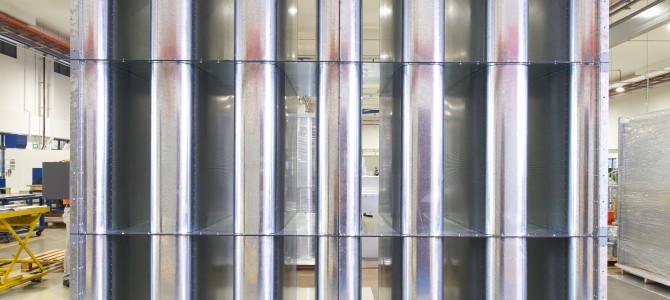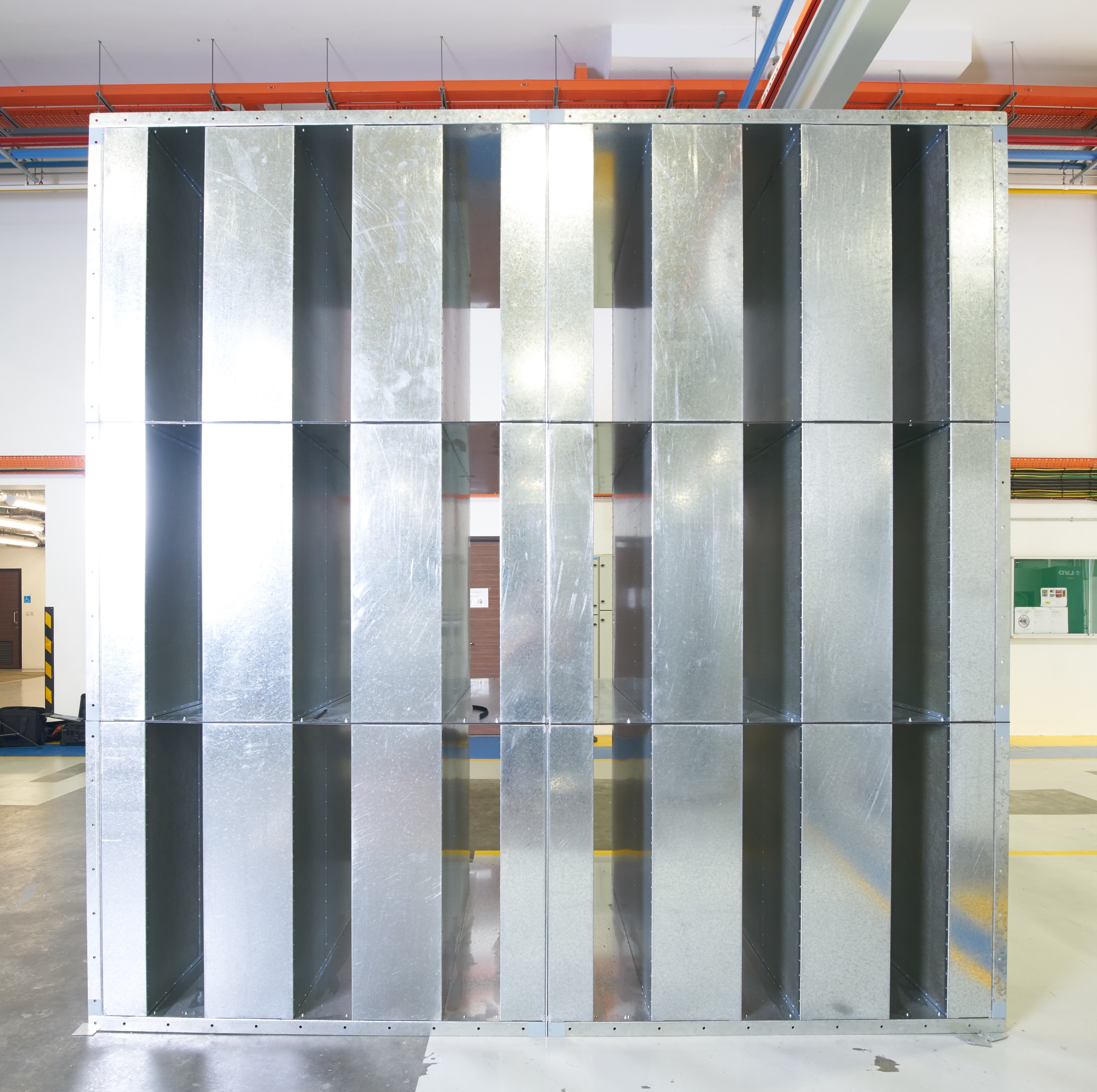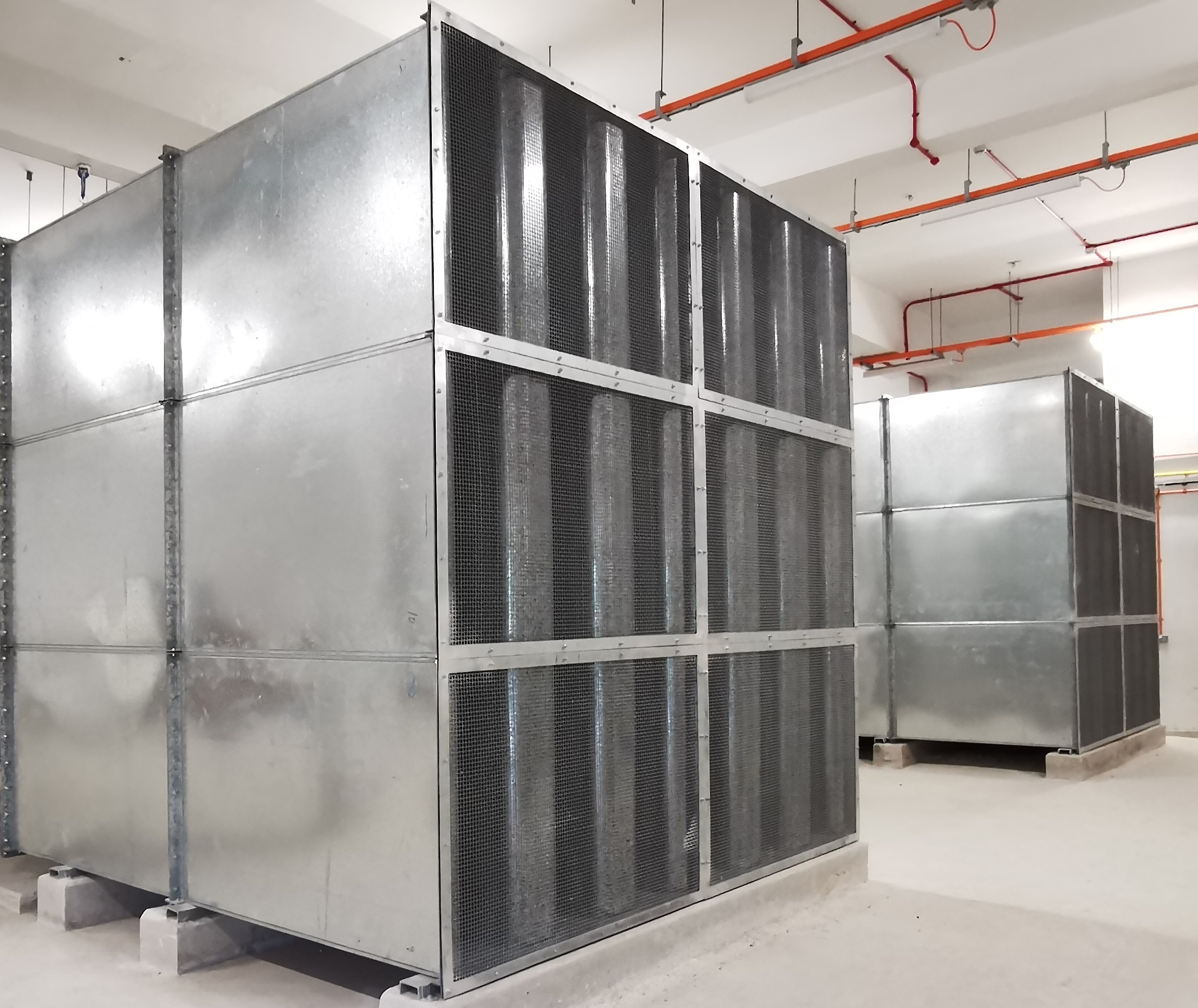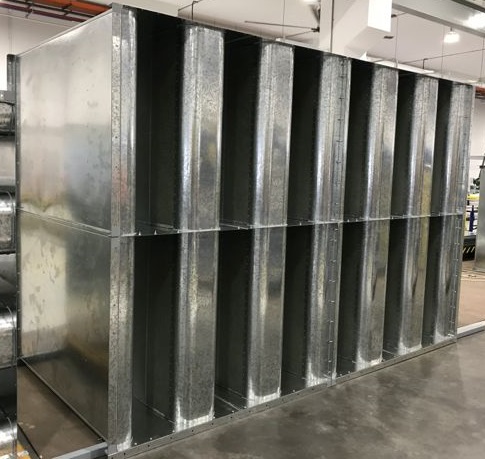Description :
All large buildings, underground tunnels, offshore oil and gas rigs are installed with air moving equipment, such as ventilation fans, air handling units, cooling towers, and exhaust systems. Unacceptable noise levels are generated by such equipment and transmitted through both the supply and return air ductworks serving the building's conditioned areas and tunnel ventilation shafts.
OLSON Acoustics has a wide range of silencers designed to provide significant noise attenuation to achieve the desired acoustical environment for all applications. The silencer may be fabricated with different materials suitable for various environments, as described in more detail below.
Read more
Construction
OLSON Acoustics' Silencers are designed with aerodynamic splitters with bullnose entrance and tapered discharge for uni-direction airflow. For bi-direction airflow, the splitter is designed with bullnose and tapered ends. The aerodynamic design ensures maximum sound attenuation with less airflow resistance and lower generated noise. The splitters are constructed with different infills and thicknesses and lining options to achieve optimum attenuation required for various applications. For all applications, the perforated metal is used to protect the infill against erosion and enhance low-frequency attenuation. The metal parts, including casing, splitter frame, and the perforated protective lining, inlet, and outlet fairings and flange may be constructed of high quality galvanized steel or stainless steel SUS 304L or SUS 316L sheet. For maximum sound attenuation, selected fiberglass is used for its splitter's acoustic infill and meets Class 'O' requirements to BS Standard BS476 Part 6 and Part 7.
Applications
OLSON Acoustics' basic silencers are fabricated of hot-dipped pre-galvanized steel for all the metal parts. The basic silencer model is the most economical in cost and is constructed following the specifications in table: Basic Specifications.
Variation in terms of material thicknesses, type of materials, type of infills, and splitter lining options is available to suit the following applications.
Indoor
Silencers used for attenuation of AHU and fan noise are constructed according to the basic specifications. Fire-resistant glass cloth may be added to protect the fiberglass infill from erosion to achieve better indoor air quality. The addition of fiberglass cloth will negatively impact the silencer's insertion loss, depending on the type of fabric used.
Outdoor
Silencers are constructed according to basic specifications except the splitter perforated sheet lining, which is replaced with 0.8 mm thick hot-dipped pre-galvanized steel. The installer should externally paint the casing and flanges with appropriate corrosion-resistant paint after installation at the site. The silencer must not be exposed to rain. If exposure to rain cannot be avoided, the silencer should be constructed of stainless steel SUS304 and the infill protected from water with an acoustically transparent polyester film. The addition of polyester film will negatively impact the silencer insertion loss, depending on the film thickness.
Cooling Tower Discharge
Silencers are constructed of stainless steel SUS304 or SUS316 to prevent corrosion from continuous exposure to warm and saturated cooling tower discharge air. The silencer installed to the cooling tower discharged is commonly located at a very high level above the roof. As such, it is very challenging and extremely costly to maintain and replace. For this reason, the most durable material should be used to ensure long-term and trouble-free operation and avoid extended downtime during maintenance or replacement. Recycled glass infill should be used to ensure long-term performance without the need for water protection. Recycle glass is resistant to water (retain its shape), UV, and heat and has good sound absorption properties.
Cooling Tower Intake
Silencers used at cooling tower intake are similar to the ones for the outdoor application. To avoid the need for polyester films, locate the silencer away from the rain or cooling tower water overspray.
Offshore Oil And Gas Platform
An offshore platform is exceptionally hazardous because people are very far out at sea and surrounded by vast combustible material and other toxic gases. Due to the extremely high cost of operating an offshore platform, the equipment, and ductwork including silencers, are robustly constructed of heavy gauge stainless steel SUS316L material for its corrosion resistance and reliability. Medium-density fiberglass is used in place of mineral wool for better insertion loss performance. If the silencer's interior parts are exposed to weather, recycled glass infill is recommended for long-term reliability. Fire-resistant glass cloth may be added to protect the fiberglass infill from erosion to achieve better indoor air quality. Using thick gauge perforated sheet and fiberglass cloth for the splitter linings will negatively impact the silencer insertion loss, depending on the type of fabric used.
Cleanroom
Silencers are constructed of hot-dipped pre-galvanized steel. Generally, silencer splitters are lined with polyester films to prevent fiberglass erosion that damages high-efficiency filters downstream. However, the use of polyester films degrades the silencer insertion loss performance. We offer alternative fire retardant acoustic foam infill that precludes polyester film protection. Acoustic foams have good sound absorption properties and withstand high velocity with negligible erosion. The acoustic foam will not damage the high-efficiency filter downstream.
Vehicular Tunnel Ventilation System
Sound attenuation is essential in the tunnel ventilation system design due to the tunnel fan high noise level. Silencers used for attenuation of fan noise are large in size and multiple modules in construction, handle massive airflow, high fan pressure, hot gases during an emergency, and taking its weight. For these reasons, the silencer is constructed of thicker gauge material on the casing, perforated lining, and splitter frames. High-performance silencers used in tunnel ventilation systems are typically very long and incur high-pressure losses. Olson Acoustics Model HABT40 tunnel ventilation silencers are designed for bi-directional airflow, low pressure loss, pressure rating of 2 kilopascals, and temperature rating of 250°C for 2 hours.
Kitchen Exhaust System
Silencers used for attenuation of kitchen exhaust fan noise are constructed according to the basic specifications. Acoustically transparent polyester films are added to the splitter lining to protect the fiberglass infill from cooking oil. Olson Acoustics Model HT400 silencer is rated to 120°C and may be removed for steam cleaning.
Features and Benefits
- Acoustic infill material are selected to achieve maximum sound insertion loss.
- Aerodynamically designed splitters with rounded nose inlet and tapered discharge significantly reduce turbulence and pressure loss, increase noise attenuation, and lower generated noise.
- Acoustic infills are protected with steel plate perforated with preferred hole size and arrangement to minimize erosion and enhance low-frequency attenuation.
- Sturdy construction with individual splitter frame design reduces casing radiated noise and enables handling and installation without damage to the silencer.
- Reliable design and construction methods prevent premature damage to the silencer.
- Large silencers are constructed in multiple modules for easy assembly on-site with accessory provided.
- All silencers are tested in our in-house accredited laboratory for pressure loss, generated noise, and sound insertion loss.
- High-quality design and construction made possible with many years of experience with acoustic applications, in-house sound testing facilities, and high-end manufacturing equipment.
- Wide range of construction materials to suit many different applications, such as indoor and outdoor applications, high-temperature applications, cooling towers, marine and offshore, clean rooms, critical environment, and underground construction.
- The silencer is cleaned, and its two ends are sealed with plastic film at the factory before delivery to keep the internal parts clean during storage at the site.
- Custom design for special requirement is available upon request.





